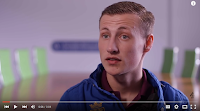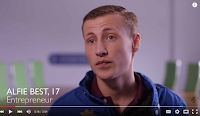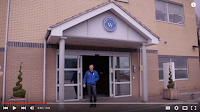Rich kids go shopping | gypsy with golden car | (2015)
produced by; channel 4
distributed by; channel 4
awards; N/A
This short documentary sticks to the conventional structure. It includes;
- interviews
- incidental music
- titles and credits
- a range of clips relating to the documentary topic
- Changes in the music according to the mood created by the person talking
The clip starts off by showing us some shots from the interview. shots shown from the interviews are at a medium close up, the camera is motionless and faces the subject at eye level;

MCU, interview clip
By using a clip from the interview before the title, it gives the audience a brief look into what the documentary is about, which is brief introduction to capture the audiences interest. High key lighting has been used and the background has been blurred out so we can focus our attention on the interviewee in the foreground.
After a brief 7 second look at this clip, the editing cuts to the title screen, Which is a black screen with white, animated typography;
Title screen
The non-diegetic soundtrack bridges from the first clip to the title screen. The soundtrack slowly fades in and gradually becomes louder. When the editing cuts to the next clip, the soundtrack fades as the non-diegetic voice over is played, but the soundtrack doesn't completely fade out and can still be heard faintly. This is done so the atmosphere created by the soundtrack remains but also so we can hear about the topic being discussed.
The next shot after the title screen cuts to an outdoor location, in which the subject is positioned in the centre of the shot as a long shot and the camera is in motion and is tracking the subject. The camera then quickly cuts to the same location but tracking the subject from a side angle. The subject is framed from a low angle at a medium close up, whilst both the non-diegetic voice over and soundtrack are being played. This is done as so it gives the audience the bigger picture and shows them the place he is describing, and so adds to the atmosphere created by the voice-over and incidental music.
It then cuts back to the interview where the voice-over is now diegetic and the subject is framed in the same position as the previous interview shot. This shot also has inter-titles in the corner on the screen giving us information about the person being interviewed such as name, age and profession.

LS, tracking
MCU, Low angle tracking

MCU, motionless
The clip then cuts back to the boy in the interview standing outdoor location at a medium long shot, in which the voice-over from the interview becomes non-diegetic whilst the soundtrack is still running in the background. The camera then cuts to a medium close up of the subject, in which the voice over becomes diegetic. The location of the interviewee differs from the previous locations and the interviewee is being interviewed in the location shown in the previous shot. Although the camera is focused is on the interviewee and the background is blurred, we can tell its the same location as the previous shot due to the lighting and the positioning of the camera in which we can make out the houses we have seen in previous shots.
The camera then cuts to long shots of other items or "props" on set of the location. The first shot shows a LS of a garden ornament and the next shot shows a LS of a bike. This gives the audience an wider picture about the location including the social class, which relates back to the topic being discussed in the voice-over in which the interviewee discusses where he came from and his previous social background. The shot then cuts back to the interview in the same outdoor location using the same positioning, which then cuts to medium long shot of the subject being tracked, whilst the voice over from the interview in the previous shot is still running. The editing has used all these shots to create an atmosphere but also to give the audience a bigger picture as to what the interviewee is talking about and so they have more to look as rather watching the interviewee talking for 2 minutes.
After the camera cuts back to the interview at the first location, The interviewee changes the topic discussion, to which the camera cuts to a new location;

XLS, motionless
The change in location also shows the change in topic in which the soundtrack bridges over unchanging as well as the voice over. The shot used is an extreme long shot in which the camera remains motionless for the duration of the shot. The camera then cuts back to the interview, medium close up shot and cuts back to another outdoor location which briefly tracks the interviewee. In this shot there is no voice over, but the camera then cuts to a Long shot of a gold car. The camera positions the car so it is in then centre of the shot but also eyeline match to the interviewee which is confirmed in the dialogue when he says "There it is". The camera also slowly focuses onto the car until all viable detail can be seen. all of this tells the audience that this car is an important part of the documentary as with the use of editing it is seen as a treasured item to the boy being interviewed.
LS, slow focus
The camera then cuts to a medium long shot of the interviewee walking up to the car, in which the camera tracks the interviewee keeping him centre of the shot. It then cuts to a medium close up of the subject looking into the car, and then a long shot of the same shot of him looking into the car. All these shots further confirm the relationship between the boy being interviewed and the car he is admiring.
The camera then cuts back to the MCU of the boy being interviewed, in which he discusses further about the car he was admiring in the previous shots. The camera then cuts to a new location which is indoors. We can tell it relates to the topic he was previously discussing as there is a white car to the left of the shot which tells the audience the topic is still about the car. Other things within the mes en scene also give hints about where he is such as the laptop and the man at the desk which tells the audience the interviewee is going to do business as desks and technology are often associated with an office or business class setup.
Another shot shows a MCU of the front bonnet of two cars in which the camera focuses on one then the other. This shot further relates to the boy being interviewed in which is also a voice over in the duration of this shot from the interviewee. The camera then cuts to a long shot of the interviewee admiring these cars, and then a medium long shot of the same shot. The camera then cuts back to the MCU interview, and then back to a long shot of him looking at more cars.
The camera then cuts to a Big Close Up (BCU) showing the price tag inside the car;

BCU
The aim of this shot relates back to the title "Rich kids", which shows how expensive the car is. It further shows the vast income the interviewee could potentially possess and also gives a rough idea about the worth of the gold car in the long shot. The next shot then further shows a long shot of the interviewee looking into the car in which we saw the price of in the previous shot. This confirms his mass income as he can afford to be interested in such a pricey car.
The camera then cuts to a mid shot of the subject walking into an office location, whilst the camera tracks from behind. It then cuts to a medium long shot of the subject sitting down behind an expensive computer. This further confirms his mass income as the brand of the Mac is visible, in which is notorious for being an expensive brand of computer. It then cuts back to the MCU of the subject being interviewed and then cuts over to a different location of a different man being interviewed;
MS
The camera is motionless and positioned at a Mid shot. The man in the shot is wearing a suit, and everything within the mes en scene relates to this theme of "office" or "business". This tells us that he is important and potentially earns a mass income. The camera then cuts to a close up of a photograph of the boy interviewed previously whilst the man being interviewed voices over. This tells us that the man being interviewed has a connection with the boy such as friend or relative. This is confirmed in the next shot when the camera cuts back to the man being interviewed and the titles come on the screen "Alfie best senior" which tells the audience the man is the boy's, or "Alfie Best's" farther.
The camera then cuts to a long shot of the boy and the car, in which there is a change in the music to something more uplifting, in which the camera cuts to a medium long shot, tracking the subject around the gold car we saw in the previous shot. The camera then cuts to another long shot of the boy looking into the car. There are then two more shots, one is a mid shot of the boy pressing buttons, and then the second shot comes to a long shot showing the car roof come off the car. All these shots have been used to show the relationship between the boy (Alfie Best) and the gold car, and also to show the cars impressive abilities which further proves how expensive it is and how much the young boy can afford, relating back to the documentary title "rich kids".
There are then more shots showing the relationship between the boy and the car including a close up of the bonnet closing, mid shot showing the inside of the car, medium close up of the boy looking into the car, and a mid shot of him getting into the car. There is also another medium close up of the boy being interviewed at 2:20, in which in the dialogue he says he brought a car because he wanted one rather than needed one. This further confirms the mass income he possesses further relating back to the title "Rich Kids".
The last shot in the documentary at 2:47 gives us a long shot, tracking the car pulling out of the drive and onto the road, in which the screen then fades out to black. There is an emphasis on the sound of the car as it accelerates into the distance which further shows its worth. This tells the audience that he now owns the expensive gold car, in which the non diegetic soundtrack suddenly becomes a lot louder and then the credits flash onto the screen.




No comments:
Post a Comment